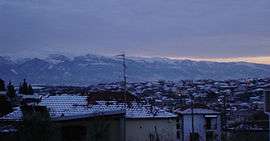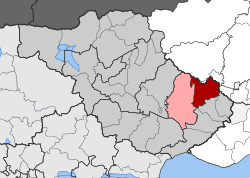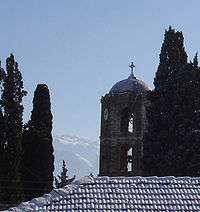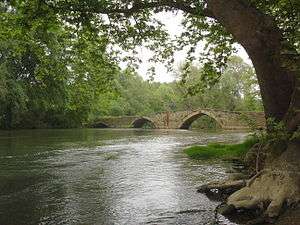Alistrati
Alistrati (Greek: Αλιστράτη) is a small town in Serres, situated at the borders of the regional unit of Drama and regional unit of Serres, in the Macedonia region of Greece. It has approximately 3,000 inhabitants, a town hall and a visitable cave.[2] It is 20 km away from Drama and 45 km away from Serres. It is a listed traditional settlement and archaeologists had found something there.[2] Since 2010 lAlistrati is part of the municipality New Zichni, of which it is a municipal unit.[3] Alistrati town has a population of 2,127 (2011) while the municipal unit has an area of 129.878 km2 and a population of 3,088 (2011).[4] Alistrati was built like an amphitheatrical inside a fascinating mountain groups on hills of the mountain range Menikio on an altitude of 325m.[5] In Alistrati there exists rising and sloping streets. Sea-winds blowing from Thassos and Staymonikon Bay influence Alistrati day by day. Alistrati, a traditional community one of the biggest of the area Zichni-Fillida. It's been up-graded to municipality of Alistrati with the "Kapodistrias" law and included the villages :Agioxori, Skopia, Mandili, Lefkothea and R.S of Aggista.[5]
Alistrati Αλιστράτη | |
|---|---|
 | |
 Alistrati Location within the regional unit  | |
| Coordinates: 41°01.552′N 24°00.642′E | |
| Country | Greece |
| Administrative region | Central Macedonia |
| Regional unit | Serres |
| Municipality | Nea Zichni |
| • Municipal unit | 129.9 km2 (50.2 sq mi) |
| Population (2011)[1] | |
| • Municipal unit | 3,088 |
| • Municipal unit density | 24/km2 (62/sq mi) |
| Community | |
| • Population | 2,127 (2011) |
| Time zone | UTC+2 (EET) |
| • Summer (DST) | UTC+3 (EEST) |
| Postal code | 62045 |
| Vehicle registration | ΕΡ |
Location and population
Alistrati is a former municipality in the Serres regional unit, Greece. Since the 2011 local government reform it is part of the municipality Nea Zichni, of which it is a municipal unit.[3] The municipal unit has an area of 129.878 km2.[4] Population: town 2,127; municipal unit 3,088 (2011). Alistrati is situated at the borders of the regional unit of Drama and regional unit of Serres. It's 20 km away from Drama and 45 km away from Serres. Alistrati was built on hills of the mountain range Menikio on an altitude of 325 m. It's been up-graded to municipality of Alistrati with the "Kapodistrias" law and included the villages: Agioxori, Skopia, Mandili, Lefkothea and R.S of Aggista.Since 2010, Alistrati is part of Nea Zichni municipality.
In the area of the town a plundered ancient Macedonian tomb has been found, which is undamaged even today, and also the traces of an ancient settlement.[6] Alistrati is mentioned in 1460 in a manuscript of the holy Convent of Ikosifissa Pageo as a small town. A traveler from Turkey mentions it with the name Al-Strati in about 1650. There are many views about the etymology of the word "Alistrati". It is said that it comes from the Archistratigos (Michael - Gabriel).

Other people believe that the first name was "Alistrate" which means among streets. Some people give her the meaning of the street towards the sea, through Fillipi. According to the tradition, the name of the town, Alistrati, comes from "Agios Eustratios", the name of a saint, because it is believed that Alistrati was built on the ruins of a church devoted to Agios Eustratios. Alistrati was built by the people of the ancient town Alektrioupolis, situated 2 km southwest from Alistrati, where the Monastery of Agia Kyriaki is now located. That town lived until the mids of the 19th century as a small settling near the big number of roosters, which crew and made their presence audible in the area around. When the town was struck by an epidemic at the beginning of the Turkish occupation, most of the inhabitants moved to the today's Alistrati place.
At the beginning Alistrati was a small village, but it soon changed into a small town because of its geographical position and the merchandise, as well. It enjoyed great prosperity during the Turkish domination as it was a tobacco's industry centre and the religious and cultural centre of East Macedonia. After the revolution of 1821 against Turkish occupation, it was a transport and trade station between the area Serres-Drama-Kavala and a business and trade activity had developed. It had also developed into an intellectual and religious center especially after it had been the seat of the See of Fillipi-Drama and Zichni (one can see the graves of three prelates in the yard of the Ag. Athanasios church) and after the establishing of the famous for that time Greek Central School of Alistrati where pupils from all the area of eastern Macedonia came to study.
Today Alistrati attracts tourists not only because of the tourist cave but because of all the natural environment around it as well. The small neighborhoods with the narrow streets and the typical up-hill alleys, the hospitable inhabitants, the nice old Square, the belfry and the elaborate old reredos of the church of Agios Athanasios are tokens of the inhabitant's taste. There are also a lot of houses built in neoclassical or Macedonian architecture and picturesque narrow streets. So as the visitor strolls around the village he can travel back into time. Visitors can enjoy their stay here in some nice places, such as Hotel Boziki or the hotel run by the Women Cooperative etc. All these places meet the visitors’ update needs. There are also many cafes, and tavernas with delicious, traditional dishes. And all these things combined with the excellent climate (there is very low humidity) help the visitors have a great time and escape from their everyday life routine.
Alistrati's Caves and Aggitis Ravine

According to the Greek Mythology, the Sphinx was appearing near the ravine of Aggitis river in the area of "Petroto". It's also been said that Pluto, master of Hades, when he had kidnapped Persephone, daughter of goddess Demeter led her to the ravine where it's believed that there were the Gates of the Underworld. The specific area which is mentioned in these Greek Myths is the same one near the Alistrati's Caves.
The Alistrati cave lies about 6 km southeast of Alistrati's town at a place called "Petroto". The expanse of the area is almost 14.000m2. The antechamber of the cave is 8 m height. It's from this point that start different high galleries folly decorated with stalactites and stalagmites. The main branches of the cave are developed to the left and to the right of the entrance starting from a huge chamber, the Teception Chamber of a width of 60 m, a length of 100 m and height of 20-30m. It's in this chamber that nature decided to demonstrate its power in creating ornaments. What fascinates the most is the huge stalactites and those pure white forming draperies. There are other chambers and their height is quite the same 8-10m. From the reception chamber and towards the left, emerges a second passage, quite parallel to the first. In this gallery there are even some red stalagmites which are called "The flames". The height of these formations reaches 35 m. Somewhere in this passages the two main passages join each other and continue with an always increasing width and height while from the ceiling one can see suspended huge and majestic stalactites of a height of 15 m.
Inside the cave there are countless floors which are still unknown. Very impressive is the big variety of stalactites and stalagmites inside the cave mostly because of the difference of their shapes and their age. The older stalactites are mainly in the galleries which are on the right side of the entrance. On the other hand, the "infant" stalactites on the left side of entrance.
- Stalactites: They are the limestone tubular formations which are growing from the ceiling and downwards. Their length fluctuates between few centimetres and many metres.
- Stalagmites: They are formed as the water drops, which carry acid carbonate, fall on the ground under a stalactite. When a stalactite meets a stalagmite, we have a new formation which is called "column"
- Helictites: It's a rear kind of stalactite which is developed on the sides, on the floors even on the ceilings of the caves, towards many directions (up, side and down).
- Shields: They are being developed as the water comes out through very thin fissures of the rock. Many times their diameter is of some metres.
- Cave Pearls: They are small formations like spheres
- Gours: They are another kind of formation which is also very interesting. Small barriers of calcium carbonate which are placed on the floor of the cave. The creation depends on the rainfall in the area of the cave. On Gour evolve a rear fauna.
The "egg- shaped " and the " Tumour - shaped " are different kinds of formatious. They are dark - coloured and usually found shaped. The " Cauliflower- like formation is another type of cave deposites. We can find them usually on the main body of a stalactite or a stalaguite.And finally the " Heccendrites in a variety of shapes.
The cave is placed 50 km away from Serres, 25 km from Drama and 55 km from Kavala. It is considered to be the most decorated cave in Greece where nature revealed its power in creating ornaments and rock formations.
At a distance of 250 m from the southern part of the entrance of the cave the railway line from Serres to Drama passes. Near the railway line and on the southern side of it is the Aggitis river. As a result of the waterflow of the river the limestone layers of the mountain has been corroded and the ravine of Aggitis river has been shaped.
The visitor in Alistrati apart from the cave can enjoy the river Aggitis which flows through the villages of Symvoli, Lefkothea and R.S. Aggista, forming idyllic river by zones with rich plantation. Many connoisseur fishermen combine their hobbies with walks and pic-nic in the countryside. The area is suitable for rafting and Kanoye. It is a few meters further down the railways which pass beside the cave. The locals call it "Vraous".
Sports
Alistrati has one football team, Makedonikos Alistratis, which plays in the A2 Local Championship. The team plays on Munipacity Stadium of Alistrati, which can seat 200 people since 2005, when the stadium upgraded.
Education
Alistrati has two schools, the Elementary School of Alistrati and the High School, which is in the same place with the Junior High School. Except that, Alistrati has 3 English Schools.
Entertainment
Alistrati, as a big village has some places for entertainment. In total Alistrati has 3 clubs that they work almost every day and 4 Internet-Cafe's.
External links
References
- "Απογραφή Πληθυσμού - Κατοικιών 2011. ΜΟΝΙΜΟΣ Πληθυσμός" (in Greek). Hellenic Statistical Authority.
- "Alistrati Serres | Alistrati Information | Alistrati Weather | Alistrati Map | Greece.com". www.greece.com. Retrieved 2018-08-21.
- Kallikratis law Greece Ministry of Interior (in Greek)
- "Population & housing census 2001 (incl. area and average elevation)" (PDF) (in Greek). National Statistical Service of Greece. Archived from the original (PDF) on 2015-09-21.
- ":: Σπήλαιο Αλιστράτης - Alistrati ::". www.alistraticave.gr. Retrieved 2018-08-21.
- Archived 2017-04-24 at the Wayback Machine D. C. Samsaris, Historical Geography of Eastern Macedonia during the Antiquity (in Greek), Thessaloniki 1976 (Society for Macedonian Studies), p. 180. ISBN 960-7265-16-5.